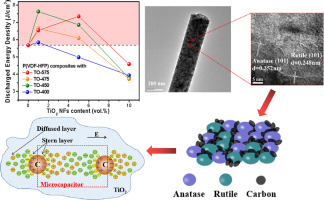当前位置:
X-MOL 学术
›
Mater. Des.
›
论文详情
Our official English website, www.x-mol.net, welcomes your
feedback! (Note: you will need to create a separate account there.)
Carbon-doped inorganic nanoassemblies as fillers to tailor the dielectric and energy storage properties in polymer-based nanocomposites
Materials & Design ( IF 7.6 ) Pub Date : 2020-03-01 , DOI: 10.1016/j.matdes.2020.108486 Huiying Chu , Chao Fu , Jingjing Xu , Weiyan Li , Jing Qian , Wei Nie , Xianghai Ran
Materials & Design ( IF 7.6 ) Pub Date : 2020-03-01 , DOI: 10.1016/j.matdes.2020.108486 Huiying Chu , Chao Fu , Jingjing Xu , Weiyan Li , Jing Qian , Wei Nie , Xianghai Ran

|
Abstract Polymer-based nanocomposites are excellent and promising in developing dielectric and energy storage applications, and one-dimensional (1D) nanofibers with large aspect ratio exhibit superiority in improving dispersibility, dielectric properties and energy storage performance of polymer nanocomposites as compared with their spherical counterparts. In this work, novel heterostructural carbon-doped inorganic nanoassemblies (TiO2/C nanofibers, NFs) were designed and synthesized in site via easy-processing electrospinning technique. Three different carbon contents of TiO2/C NFs were obtained as 2 wt%, 4.5 wt% and 13.6 wt% by regulating precalcination conditions, respectively. P(VDF-HFP) was chosen to incorporate with different nanofibers as prepared due to its relatively high dielectric constant. A comparative study on dielectric energy storage performance of the TiO2/C NFs/P(VDF-HFP) nanocomposites has been systematically presented. The results reveal that the dielectric constant and the energy density are significantly enhanced for nanocomposites with appropriate content of doped carbon inside NFs. At relatively low doping content, the carbon nanoparticles could well disperse in TiO2/C NFs for forming numerous micro-capacitors, which is beneficial for enhancing interfacial polarization and suppressing loss. This work provides insights into the effect of the carbon-doped nanoassemblies for further improving energy storage capability of polymer nanocomposites for high-performance device applications.
中文翻译:

碳掺杂无机纳米组件作为填料来调整聚合物基纳米复合材料的介电和储能性能
摘要 聚合物基纳米复合材料在开发介电和储能应用方面表现出色且前景广阔,与球形对应物相比,具有大纵横比的一维(1D)纳米纤维在改善聚合物纳米复合材料的分散性、介电性能和储能性能方面表现出优势。 . 在这项工作中,通过易加工的静电纺丝技术设计和合成了新型异质结构碳掺杂无机纳米组件(TiO2/C 纳米纤维,NFs)。通过调节预煅烧条件,得到了三种不同碳含量的 TiO2/C NFs,分别为 2 wt%、4.5 wt% 和 13.6 wt%。由于 P(VDF-HFP) 具有相对较高的介电常数,因此选择 P(VDF-HFP) 与制备的不同纳米纤维结合。对TiO2/C NFs/P(VDF-HFP)纳米复合材料的介电储能性能进行了比较研究。结果表明,纳米复合材料的介电常数和能量密度显着提高,纳米复合材料中掺杂碳含量适当。在相对较低的掺杂含量下,碳纳米颗粒可以很好地分散在 TiO2/C NFs 中,形成众多的微型电容器,有利于增强界面极化和抑制损耗。这项工作提供了对碳掺杂纳米组件对进一步提高聚合物纳米复合材料在高性能器件应用中的储能能力的影响的见解。结果表明,纳米复合材料的介电常数和能量密度显着提高,纳米复合材料中掺杂碳含量适当。在相对较低的掺杂含量下,碳纳米颗粒可以很好地分散在 TiO2/C NFs 中,形成众多的微型电容器,有利于增强界面极化和抑制损耗。这项工作提供了对碳掺杂纳米组件对进一步提高聚合物纳米复合材料在高性能器件应用中的储能能力的影响的见解。结果表明,纳米复合材料的介电常数和能量密度显着提高,纳米复合材料中掺杂碳含量适当。在相对较低的掺杂含量下,碳纳米颗粒可以很好地分散在 TiO2/C NFs 中,形成众多的微型电容器,有利于增强界面极化和抑制损耗。这项工作提供了对碳掺杂纳米组件对进一步提高聚合物纳米复合材料在高性能器件应用中的储能能力的影响的见解。这有利于增强界面极化和抑制损耗。这项工作提供了对碳掺杂纳米组件对进一步提高聚合物纳米复合材料在高性能器件应用中的储能能力的影响的见解。这有利于增强界面极化和抑制损耗。这项工作提供了对碳掺杂纳米组件对进一步提高聚合物纳米复合材料在高性能器件应用中的储能能力的影响的见解。
更新日期:2020-03-01
中文翻译:

碳掺杂无机纳米组件作为填料来调整聚合物基纳米复合材料的介电和储能性能
摘要 聚合物基纳米复合材料在开发介电和储能应用方面表现出色且前景广阔,与球形对应物相比,具有大纵横比的一维(1D)纳米纤维在改善聚合物纳米复合材料的分散性、介电性能和储能性能方面表现出优势。 . 在这项工作中,通过易加工的静电纺丝技术设计和合成了新型异质结构碳掺杂无机纳米组件(TiO2/C 纳米纤维,NFs)。通过调节预煅烧条件,得到了三种不同碳含量的 TiO2/C NFs,分别为 2 wt%、4.5 wt% 和 13.6 wt%。由于 P(VDF-HFP) 具有相对较高的介电常数,因此选择 P(VDF-HFP) 与制备的不同纳米纤维结合。对TiO2/C NFs/P(VDF-HFP)纳米复合材料的介电储能性能进行了比较研究。结果表明,纳米复合材料的介电常数和能量密度显着提高,纳米复合材料中掺杂碳含量适当。在相对较低的掺杂含量下,碳纳米颗粒可以很好地分散在 TiO2/C NFs 中,形成众多的微型电容器,有利于增强界面极化和抑制损耗。这项工作提供了对碳掺杂纳米组件对进一步提高聚合物纳米复合材料在高性能器件应用中的储能能力的影响的见解。结果表明,纳米复合材料的介电常数和能量密度显着提高,纳米复合材料中掺杂碳含量适当。在相对较低的掺杂含量下,碳纳米颗粒可以很好地分散在 TiO2/C NFs 中,形成众多的微型电容器,有利于增强界面极化和抑制损耗。这项工作提供了对碳掺杂纳米组件对进一步提高聚合物纳米复合材料在高性能器件应用中的储能能力的影响的见解。结果表明,纳米复合材料的介电常数和能量密度显着提高,纳米复合材料中掺杂碳含量适当。在相对较低的掺杂含量下,碳纳米颗粒可以很好地分散在 TiO2/C NFs 中,形成众多的微型电容器,有利于增强界面极化和抑制损耗。这项工作提供了对碳掺杂纳米组件对进一步提高聚合物纳米复合材料在高性能器件应用中的储能能力的影响的见解。这有利于增强界面极化和抑制损耗。这项工作提供了对碳掺杂纳米组件对进一步提高聚合物纳米复合材料在高性能器件应用中的储能能力的影响的见解。这有利于增强界面极化和抑制损耗。这项工作提供了对碳掺杂纳米组件对进一步提高聚合物纳米复合材料在高性能器件应用中的储能能力的影响的见解。











































 京公网安备 11010802027423号
京公网安备 11010802027423号